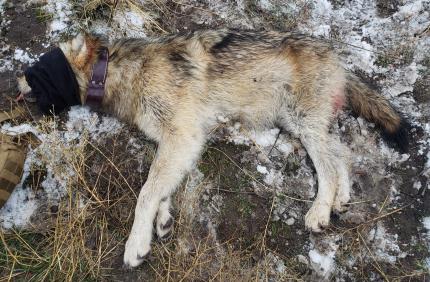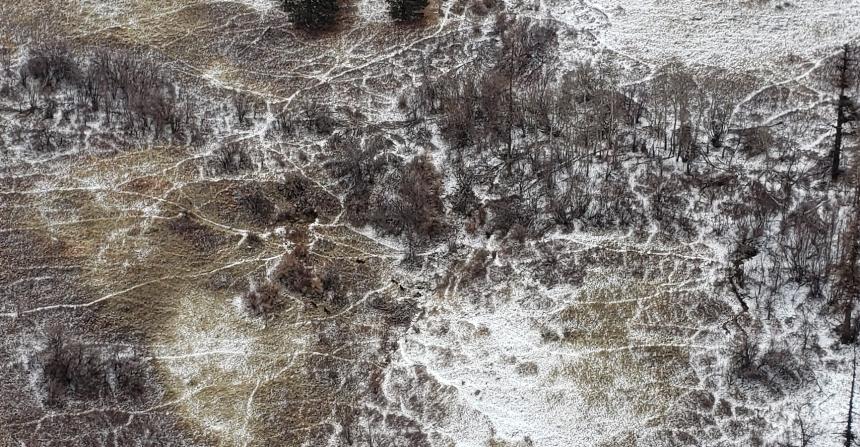This update provides an overview of gray wolf conservation and management activities in Washington during February 2021.
Program updates
The annual wolf population survey is underway and WDFW staff are developing the 2020 annual wolf report. The report will be released in April.
Communication and coordination
- On Feb. 8, WDFW published a blog post about what to expect when wolves expand to new areas in Washington. WDFW also published a video about Washington wolf encounters and safety in wolf country.
- District 1 WDFW conflict staff held a virtual meeting with representatives from Cattle Producers of Washington (CPOW), Northeast Washington Wolf-Cattle Collaborative (NEWCC), and the Colville National Forest. The goal of the meeting was to increase coordination and create a draft spreadsheet with plans for allotment coverage with range riders. Forest Service staff informed the team of which allotments will not be grazed during the upcoming season. WDFW scheduled monthly meetings on this topic prior to the grazing season.
- District 3 WDFW land management, wildlife conflict, and wildlife management staff developed draft Annual Operating Plans for five different WDFW grazing leases. The plans were then reviewed by Senior Managers from Lands Division, Wolf Policy, and Region 1. These plans describe wolf/livestock deterrence measures for livestock producers with grazing leases on WDFW lands. The plans will be shared with the producers and attached to their grazing lease documents.
Current population status and proactive conflict mitigation
The year-end minimum population count for 2019 was at least 108 known wolves in 21 known packs including at least 10 breeding pairs. The Confederated Tribes of the Colville Reservation reported 37 wolves in five packs. Annual wolf population surveys are conducted in the winter because wolf populations experience the least amount of natural fluctuation during this time. Counting the population at the end of each year allows for comparable year-to-year trends at a time of year when the wolf population is most stable. The year-end minimum population count for 2020 will be released in April 2021.
Reports of remote camera images or videos, wolf tracks, or sightings from the public are extremely helpful in locating previously undocumented wolf activity and potential new packs on the landscape. Please take photos of wolves or wolf sign (use some way to measure the size of a track) and upload them to the wolf reporting page via the following link: https://wdfw.wa.gov/species-habitats/at-risk/species-recovery/gray-wolf/observations
Definitions: A “pack” is defined as two or more wolves traveling together in winter, and a “breeding pair” is defined as at least one adult male and one adult female wolf that raised at least two pups that survived until December 31. In any given year, the number of packs will always be greater than or equal to the number of breeding pairs. The known territories and more information for each pack can be viewed by clicking the pack name.
Beaver Creek pack
Biologists conducted a track survey and checked cameras in the Beaver Creek territory this past month to inform the annual population count.
Butte Creek pack
No activity to report.
Carpenter Ridge pack
Biologists attempted to capture wolves in this pack via helicopter but were unsuccessful.
Diobsud Creek pack
No activity to report.
Dirty Shirt pack
No activity to report.
Goodman Meadows pack
No activity to report.
Grouse Flats pack
Biologists attempted to capture wolves in this pack via helicopter but were unsuccessful.
Huckleberry pack
No activity to report.
Kettle pack
Biologists checked cameras and conducted track surveys in this area to inform the annual population count.
Leadpoint pack
Biologists conducted wolf surveys in this area to inform the annual population count.
Lookout pack
No activity to report.
Loup Loup pack
No activity to report.
Naneum pack
As previously reported, biologists captured and collared a three-year-old male in this pack via helicopter in January.

Salmo pack
No activity to report.
Sherman pack
Biologists conducted wolf surveys in this area to inform the annual population count.
Smackout pack
Biologists attempted to capture wolves in this pack via helicopter but were unsuccessful.
Stranger pack
No activity to report.
Strawberry pack
No activity to report.
Sullivan Creek pack
No activity to report.
Teanaway pack
Biologists attempted to capture wolves in this pack via helicopter but were unsuccessful.
Togo pack
During the aerial capture effort, biologists searched the Togo pack territory for signals from a collar that had stopped transmitting GPS locations last October. The collar battery has most likely died; no signals were located during aerial surveys. Biologists conducted track surveys in this area this past month to inform the annual population count.
Touchet pack
Biologists attempted to capture wolves in this pack via helicopter but were unsuccessful.

Tucannon pack
No activity to report.
Wedge pack
No activity to report.
Miscellaneous/lone wolves
Biologists collared a wolf in an area west of the Smackout pack territory where they documented some recent wolf activity. Biologists conducted track surveys and checked cameras in the South Cascades and in an area north of lake Chelan this past month to inform the annual population count.
Note: The Frosty, Nason, Nc’icn, and Whitestone pack territories are within Confederated Tribes of the Colville Reservation (CTCR) lands and are managed under tribal authority. Information regarding these packs is proprietary and reported at the discretion of the CTCR.
Mortalities
A dispersing collared wolf that Spokane Tribe had collared in the Huckleberry pack territory was found dead near Sprague, WA. As of this update, WDFW has documented one wolf mortality in 2021.
Depredation activity
Please report any suspected livestock depredations or the death or harassment of wolves to the WDFW Enforcement Hotline at 1-877-933-9847.
In 2020, 76% of known wolf packs were not involved in any documented livestock depredation.
There were no documented wolf depredations in February.
Below is a summary of packs with documented depredation activity within the past ten months (some packs have depredation history prior to the current ten-month window; this timeframe is considered based on guidance from the wolf-livestock interaction protocol (PDF)).
|
Pack |
Depredation date |
Depredation type |
Proactive non-lethals |
Ten-month window |
Agency lethal removal actions |
|
Beaver Creek |
8/21/20 |
Probable injury of calf |
Yes |
6/21/21 |
|
|
Leadpoint |
6/19/20 |
Confirmed injury of calf |
Yes |
4/19/21 |
|
|
|
6/19/20 |
Confirmed injury of two calves |
Yes |
4/19/21 |
|
|
|
6/19/20 |
Confirmed injury of calf |
Yes |
4/19/21 |
|
|
|
6/28/20 |
Confirmed injury of calf |
Yes |
4/28/21 |
|
|
|
8/3/20 |
Confirmed mortality of calf (calf died from injuries) |
Yes |
6/3/21 |
|
|
|
8/7/20 |
Confirmed injury of calf |
Yes |
6/7/21 |
|
|
|
8/7/20 |
Confirmed injury of calf |
Yes |
6/7/21 |
|
|
|
8/7/20 |
Confirmed injury of calf |
Yes |
6/7/21 |
|
|
|
8/7/20 |
Confirmed kill of calf |
Yes |
6/7/21 |
|
|
|
8/10/20 |
Confirmed injury of calf |
Yes |
6/10/21 |
|
|
|
8/10/20 |
Confirmed kill of calf |
Yes |
6/10/21 |
|
|
|
8/14/20 |
Confirmed injury of calf |
Yes |
6/14/21 |
|
|
Togo |
6/6/20 |
Confirmed injury of calf |
Yes |
4/6/21 |
|
|
Grouse Flats |
8/12/20 |
Probable injury of calf |
Yes |
6/12/21 |
|
|
Smackout |
4/3/20 |
Confirmed injury of calf |
Yes |
2/3/21 |
|
|
|
7/24/20 |
Confirmed kill of calf |
Yes |
5/24/21 |
|
|
Touchet |
1/16/21 |
Probable kill of calf |
No |
11/16/21 |
|
|
Wedge |
5/11/20 |
Confirmed injury of calf |
Yes |
3/11/21 |
|
|
|
5/19/20 |
Confirmed kill of calf |
Yes |
3/19/21 |
|
|
|
5/19/20 |
Confirmed injury of calf |
Yes |
3/19/21 |
|
|
|
6/17/20 |
Confirmed injury of calf |
Yes |
4/17/21 |
|
|
|
7/11/20 |
Confirmed injury of three calves |
Yes |
5/11/21 |
|
|
|
7/11/20 |
Confirmed injury of calf |
Yes |
5/11/21 |
|
|
|
7/11/20 |
Confirmed injury of calf |
Yes |
5/11/21 |
|
|
|
7/11/20 |
Confirmed injury of two calves |
Yes |
5/11/21 |
|
|
|
7/13/20 |
Confirmed injury of calf |
Yes |
5/13/21 |
|
|
|
7/25/20 |
Confirmed kill of calf and injury of calf |
Yes |
5/25/21 |
Adult female lethally removed 7/27/20 |
|
|
7/29/20 |
Probable kill of calf |
Yes |
5/29/21 |
|
|
|
7/29/20 |
Confirmed injury of two calves |
Yes |
5/29/21 |
|
|
|
7/30/20 |
Confirmed injury of two calves |
Yes |
5/30/21 |
|
|
|
7/31/20 |
Confirmed injury of two calves |
Yes |
5/31/21 |
|
|
|
7/31/20 |
Confirmed injury of calf |
Yes |
5/31/21 |
|
|
|
8/1/20 |
Confirmed injury of calf |
Yes |
6/1/21 |
Adult male and female lethally removed 8/13/20 |